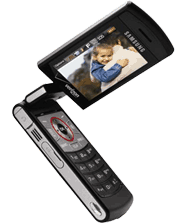Sanyo’s M1 and Apple’s iPhone both include 2.0-megapixel cameras that take decent quality photos, and Blackberry phones include a built-in flash with their 2.0-megapixel cameras.
More recently the Samsung Flipshot hit the market with a high quality 3.0-megapixel camera; putting it head and shoulders above typical camera phones like the Motorola RAZR V3 with it’s low-end 1.3-megapixel camera.
In fact, most cell phones still come with low resolution 1.3 megapixel VGA cameras that take low quality pictures; just enough to capture the moment, but nothing you’d want to show off in a photography contest.
You can still pull off a little magic though with your existing camera phone, provided you follow a few simple guidelines:
1.  Stillshots are better than motion shots
Stillshots are better than motion shots
If you can get your subject to hold still, the picture will turn out sharper and more recognizable. Action shots – especially with the slight delay inherent to digital cameras – will turn out very blurry or bitmapped on a camera phone (that choppy look you get from a low-res camera).
2. Lighting is everything
Take your photos outside with plenty of light. Most camera phones don’t come with a flash, which means they’ll use a longer shutter time indoors to capture more light – resulting in an overall blurry picture, since subjects will be moving while the shutter remains open.
Avoid too much bright sun however, since it can create unattractive deep facial shadows if your shot is taken into the sun. A good rule of thumb is to always keep the sun behind you, which will illuminate your subject and get rid of ugly shadows.
3. Close-ups are better than long shots
Cell phone camera technology is changing rapidly, and manufacturers are starting to bundle higher resolution cameras with their cell phones.
Sanyo’s M1 and Apple’s iPhone both include 2.0-megapixel cameras that take decent quality photos, and Blackberry phones include a built-in flash with their 2.0-megapixel cameras.
More recently the Samsung Flipshot hit the market with a high quality 3.0-megapixel camera; putting it head and shoulders above typical camera phones like the Motorola RAZR V3 with it’s low-end 1.3-megapixel camera.
In fact, most cell phones still come with low resolution 1.3 megapixel VGA cameras that take low quality pictures; just enough to capture the moment, but nothing you’d want to show off in a photography contest.
You can still pull off a little magic though with your existing camera phone, provided you follow a few simple guidelines:
1.  Stillshots are better than motion shots
Stillshots are better than motion shots
If you can get your subject to hold still, the picture will turn out sharper and more recognizable. Action shots – especially with the slight delay inherent to digital cameras – will turn out very blurry or bitmapped on a camera phone (that choppy look you get from a low-res camera).
2. Lighting is everything
Take your photos outside with plenty of light. Most camera phones don’t come with a flash, which means they’ll use a longer shutter time indoors to capture more light – resulting in an overall blurry picture, since subjects will be moving while the shutter remains open.
Avoid too much bright sun however, since it can create unattractive deep facial shadows if your shot is taken into the sun. A good rule of thumb is to always keep the sun behind you, which will illuminate your subject and get rid of ugly shadows.
3. Close-ups are better than long shots
With only 1.3 megapixels, you just plain aren’t going to be able to recognize faces and expressions at more than about 10 feet away. Get in close and you’ll have a much better chance of capturing important details.
4. Look your subject in the eye
Direct eye contact can be as engaging in a picture as it is in real life. Hold the camera at your subject’s eye level to capture their magnetic gazes and mesmerizing smiles. For children, that means stooping to their level. And always remember that smiles are contagious.
5. Use a plain background
A plain background shows off the subject you are photographing. When you look through the camera viewfinder, force yourself to study the area surrounding your subject. Make sure no poles grow from the head of your favorite niece and that no cars seem to dangle from her ears.
These tips will help you get the most out of your cell phone’s camera – which will usually be just good enough to tell the story, but not good enough to enter any contests.